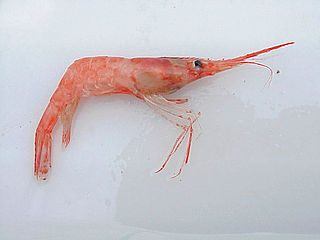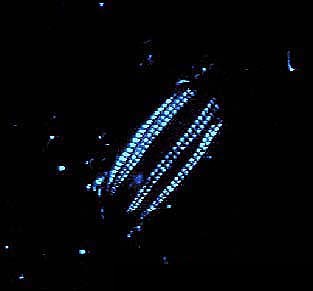
Ctenophora comprise a phylum of marine invertebrates, commonly known as comb jellies, that inhabit sea waters worldwide. They are notable for the groups of cilia they use for swimming, and they are the largest animals to swim with the help of cilia.

Tentaculata is a class of comb jellies, one of two classes in the phylum Ctenophora. The common feature of this class is a pair of long, feathery, contractile tentacles, which can be retracted into specialised ciliated sheaths. In some species, the primary tentacles are reduced and they have smaller, secondary tentacles. The tentacles have colloblasts, which are sticky-tipped cells that trap small prey.

Beroidae is a family of ctenophores or comb jellies more commonly referred to as the beroids. It is the only known family within the monotypic order Beroida and the class Nuda. They are distinguished from other comb jellies by the complete absence of tentacles, in both juvenile and adult stages. Species of the family Beroidae are found in all the world's oceans and seas and are free-swimmers that form part of the plankton.

The Cyclopteridae are a family of marine fishes, commonly known as lumpsuckers or lumpfish, in the order Scorpaeniformes. They are found in the cold waters of the Arctic, North Atlantic, and North Pacific oceans. The greatest number of species are found in the North Pacific. The family name Cyclopteridae derives from the Greek words κύκλος (kyklos), meaning "circle", and πτέρυξ (pteryx), meaning "wing" or "fin", in reference to the circle-shaped pectoral fins of most of the fish in this family.

Cydippida is an order of comb jellies. They are distinguished from other comb jellies by their spherical or oval bodies, and the fact their tentacles are branched, and can be retracted into pouches on either side of the pharynx. The order is not monophyletic, that is, more than one common ancestor is believed to exist.

Platyctenida is an order of comb jellies in the class Tentaculata.
Eurhamphaeidae is a family of ctenophores.

Pandalus is a genus of shrimp in the family Pandalidae. Members of the genus are medium-sized and live on or near the seabed. Some species are the subject of commercial fisheries and are caught by trawling. One species, Pandalus montagui, lives in association with the reef-building polychaete worm, Sabellaria spinulosa.

The benthic comb jelly is a comb jelly living in the Ryukyu Trench near Japan. Found at a depth of 7,217 metres (23,700 ft), it is the deepest dwelling ctenophore discovered. Since its discovery, similar comb jellies have been found in the New Britain and Yap trenches.

Leucothea is a genus of ctenophores in the monotypic family Leucotheidae.

Beroe, commonly known as the cigar comb jellies, is a genus of comb jellies in the family Beroidae. Beroe exhibits bioluminescence.

Coeloplana is a genus of ctenophores, and are marine invertebrates. Species include:
Coeloplana yulianicorum is a species of benthic comb jelly. It is known from the Red Sea and lives as an episymbiont on the soft coral Sarcophyton yulianicorum. It can be differentiated from congeneric species by their host, colour, and colour pattern.
Coeloplana huchonae is a species of benthic comb jelly. It is known from the Red Sea and lives as an episymbiont on the stems of the soft coral Dendronephthya hemprichi. It can be differentiated from its congeneric species by their host, colour, and colour pattern.
Coeloplana fishelsoni is a species of benthic comb jelly. It is known from the Red Sea and lives as an episymbiont on colonies of Xenia umbellata and Paralemnalia species. It can be differentiated from its congeneric species by their host, colour, and colour pattern.

Euplokamis is a genus of ctenophores, or comb jellies, belonging to the monotypic family Euplokamididae. It shares the common name sea gooseberry with species of the genus Pleurobrachia. After being originally described by Chun (1879), the family Euplokamididae was expanded by Mills (1987) due to the discovery of a new species, Euplokamis dunlapae. Further research indicated that Euplokamis should be identified from Mertensiidae due to the rows of combs and some compression. They may also be distinguished from the genus Pleurobrachia due to their more elongated shape. Additionally, various adaptations of Euplokamis have been observed such as the use of tentacles for movement/feeding, a complex nervous system, and bioluminescent capabilities. Other characteristics including a defined mesoderm, lack of stinging cells, developmental differences, and symmetry supported the reclassification of these organisms.
Platyctenidae is a family of ctenophores belonging to the order Platyctenida.
Tjalfiellidae is a family of ctenophores belonging to the order Platyctenida.
Lampea is a genus of ctenophores belonging to the family Lampeidae.

Coeloplana meteoris, is a species of benthic comb jelly native to the Indo-Pacific region that has also been found in the Arabian-Persian gulf.












